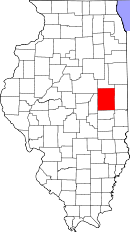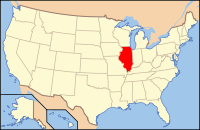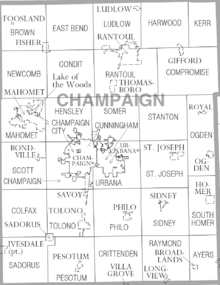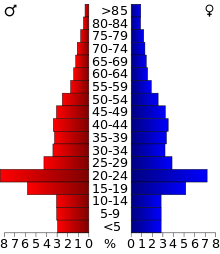- Champaign County, Illinois
-
Champaign County, Illinois 
Seal
Location in the state of Illinois
Illinois's location in the U.S.Founded 1833 Seat Urbana Largest city Champaign Area
- Total
- Land
- Water
998.39 sq mi (2,586 km²)
996.27 sq mi (2,580 km²)
2.13 sq mi (6 km²), 0.21%Population
- Density
201,081
191/sq mi (74/km²)Time zone Central: UTC-6/-5 Website www.co.champaign.il.us Champaign County is a county located in the U.S. state of Illinois. According to the 2010 census, it has a population of 201,081, which is an increase of 11.9% from 179,669 in 2000.[1]. It is the 10th most populous county in Illinois. Its county seat is Urbana.[2]
Champaign County is part of the Champaign–Urbana Metropolitan Statistical Area.
Contents
History
Champaign County was organized in 1833, having been previously a part of Vermilion County. The county and county seat were named for Champaign County, Ohio and Urbana, Ohio respectively, the homeplace of the Illinois legislator who sponsored the bill to create the county. The development of the county was greatly furthered by the arrival of the Chicago Branch of the Illinois Central Railroad, and even more by the establishment of the land-grant university. Later, the county also got an airport and a mass transit district. The northern part of the county experienced an economic and demographic setback with the closing of Chanute Air Training Center in the 1990s. In the 2004 Presidential election, it was one of only 15 of the 102 Illinois counties in which John Kerry received a majority of the vote (50.98%).[3]
Geography
According to the 2010 census, the county has a total area of 998.39 square miles (2,585.8 km2), of which 996.27 square miles (2,580.3 km2) (or 99.79%) is land and 2.13 square miles (5.5 km2) (or 0.21%) is water.[4]
Because Champaign County is situated on a large and very flat plateau, it had virtually no natural drainage, so that much of the County consisted of wetlands until drainage ditches were built, beginning in the 1870s. This was an example of an upland marsh, which resulted in a high incidence of malaria before the late nineteenth century.
The topography of Champaign County was formed by the Wisconsin Glacier about 10,000 years before the present. Lobes of ice from what is now Lake Michigan crossed the county, creating a deep pile of glacial soil, up to 300 feet thick, topped by numerous moraines forming small, flat watersheds with no outlets.
Champaign County is situated on the divide between the Ohio and Mississippi Rivers. Rivers flow out of Champaign County to the east, west, and south. The Kaskaskia River has its origin to the northwest of Champaign, draining the western side of that City. The Kaskaskia flows toward the southwest, joining the Mississippi south of St. Louis, Missouri.
The Embarras River, on the other hand, drains the south-central portion of the Champaign-Urbana Metropolitan Area, originating in southeastern Champaign and flowing through the experimental fields on the southern part of the campus of the University of Illinois. The Embarras is tributary to the Wabash River and Ohio River systems. The northeast corner of Champaign, the central portion of the University campus, and the northern part of Urbana are drained by the Boneyard Creek, which flows into the Saline Ditch, a tributary of the Vermilion and Wabash Rivers.
Adjacent counties
- Ford County - north
- Vermilion County - east
- Edgar County - southeast (at a single point)
- Douglas County - south
- Piatt County - west
- McLean County - northwest
Transportation
Major highways
 Interstate 57
Interstate 57 Interstate 72
Interstate 72 Interstate 74
Interstate 74 US Route 45
US Route 45 US Route 136
US Route 136 US Route 150
US Route 150 Illinois Route 10
Illinois Route 10 Illinois Route 47
Illinois Route 47 Illinois Route 49
Illinois Route 49 Illinois Route 54
Illinois Route 54 Illinois Route 130
Illinois Route 130
Airports
The following public-use airports are located in the county:[5]
- University of Illinois Willard Airport (CMI) - Champaign-Urbana
- Rantoul National Aviation Center (Frank Elliott Field) (TIP) - Rantoul
- Frasca Field (C16) - Urbana
Political subdivisions
Cities
Villages
Townships
Unincorporated communities
Demographics
Historical populations Census Pop. %± 1900 47,622 — 1910 51,829 8.8% 1920 56,959 9.9% 1930 64,273 12.8% 1940 70,578 9.8% 1950 106,100 50.3% 1960 132,436 24.8% 1970 163,281 23.3% 1980 168,392 3.1% 1990 173,025 2.8% 2000 179,669 3.8% 2010 201,081 11.9% IL Counties 1900-1990 As of the census[6] of 2000, there were 179,669 people, 70,597 households, and 39,322 families residing in the county. The population density was 180 people per square mile (70/km²). There were 75,280 housing units at an average density of 76 per square mile (29/km²). The racial makeup of the county was 78.78% White, 11.16% Black or African American, 0.24% Native American, 6.45% Asian, 0.04% Pacific Islander, 1.34% from other races, and 1.99% from two or more races. 2.90% of the population were Hispanic or Latino of any race. 23.9% were of German, 9.6% Irish, 8.9% English and 7.4% American ancestry according to Census 2000. 88.7% spoke English, 2.9% Spanish, 1.7% Chinese or Mandarin and 1.3% Korean as their first language.
There were 70,597 households out of which 27.20% had children under the age of 18 living with them, 43.60% were married couples living together, 9.20% had a female householder with no husband present, and 44.30% were non-families. 31.40% of all households were made up of individuals and 7.80% had someone living alone who was 65 years of age or older. The average household size was 2.33 and the average family size was 2.96.
In the county the population was spread out with 21.00% under the age of 18, 23.10% from 18 to 24, 28.20% from 25 to 44, 18.00% from 45 to 64, and 9.70% who were 65 years of age or older. The median age was 29 years. For every 100 females there were 101.10 males. For every 100 females age 18 and over, there were 99.70 males.
The median income for a household in the county was $37,780, and the median income for a family was $52,591. Males had a median income of $36,844 versus $26,421 for females. The per capita income for the county was $19,708. About 6.90% of families and 16.10% of the population were below the poverty line, including 11.80% of those under age 18 and 4.90% of those age 65 or over.
The Champaign County Economic Development Corporation (CHCEDC) produced a 2009 County Demographic Profile which includes information on the population, labor, housing, cost of living, education, taxes, retail sales, transportation, quality of life, utilities.[7] CHCEDC also conducts labor force studies every two years and labor shed studies every few years.[8]
Economy
Supported by the University of Illinois, through such backings like Research Park, and Champaign County leaders, the area has shown even more growth in Information Technology, Micro/Nanotechnology, Bio-Imaging, Healthcare, Logistics, Distribution and Agribusiness in recent years.[9]
The Top 2009 Employers of the county are the University of Illinois, Carle Clinic Association, Carle Foundation Hospital, Champaign Schools Unit 4, Kraft Foods, Provena Covenant Medical, Parkland College, Kirby Foods, Christie Clinic Association, Urbana Schools District and Hobbico.[10]
Climate and weather
Urbana, Illinois Climate chart (explanation) J F M A M J J A S O N D 1.93216238213.249303.762404.874514.283604.785644.483623.278542.865433.550332.83722Average max. and min. temperatures in °F Precipitation totals in inches Source: The Weather Channel[11] Metric conversion J F M A M J J A S O N D 480-9513-6829-19317412223111072816119291811128178226127118688101703-6Average max. and min. temperatures in °C Precipitation totals in mm In recent years, average temperatures in the county seat of Urbana have ranged from a low of 16 °F (−9 °C) in January to a high of 85 °F (29 °C) in July, although a record low of −25 °F (−32 °C) was recorded in January 1999 and a record high of 109 °F (43 °C) was recorded in July 1954. Average monthly precipitation ranged from 1.90 inches (48 mm) in January to 4.80 inches (122 mm) in May.[11]
See also
National Register of Historic Places listings in Champaign County, Illinois
References
- ^ "Champaign County QuickFacts". United States Census Bureau. http://quickfacts.census.gov/qfd/states/17/17019.html. Retrieved 2011-11-05.
- ^ "Find a County". National Association of Counties. http://www.naco.org/Counties/Pages/FindACounty.aspx. Retrieved 2011-06-07.
- ^ "Presidential vote by county - Illinois". USA Today. 2004-10-27. http://www.usatoday.com/news/politicselections/vote2004/PresidentialByCounty.aspx?oi=P&rti=G&tf=l&sp=IL.
- ^ "Census 2010 U.S. Gazetteer Files: Counties". United States Census. http://www.census.gov/geo/www/gazetteer/files/Gaz_counties_national.txt. Retrieved 2011-11-05.
- ^ Public and Private Airports, Champaign County, Illinois
- ^ "American FactFinder". United States Census Bureau. http://factfinder.census.gov. Retrieved 2008-01-31.
- ^ http://www.champaigncountyedc.org/ChampaignDemographicProfile110409.pdf
- ^ http://www.champaigncountyedc.org/Workforce.html
- ^ http://www.champaigncountyedc.org/technology.html
- ^ http://www.champaigncountyedc.org/TopEmployers.html
- ^ a b "Monthly Averages for Urbana, Illinois". The Weather Channel. http://www.weather.com/weather/wxclimatology/monthly/graph/USIL1191. Retrieved 2011-01-27.
Bibliography
- Mathews, Milton W; McLean, Lewis A. (1886). Early History and Pioneers of Champaign County. Urbana, Illinois: Champaign County Herald. http://www.archive.org/stream/earlyhistorypion00math#page/n5/mode/2up. Retrieved 2010-11-29.
- Stewart, J. R., ed (1918). A Standard History of Champaign County Illinois. 1. Chicago and New York: The Lewis Publishing Company. http://www.archive.org/stream/standardhistoryov1stew#page/n9/mode/2up. Retrieved 2010-11-29.
- Stewart, J. R., ed (1918). A Standard History of Champaign County Illinois. 2. Chicago and New York: The Lewis Publishing Company. http://www.archive.org/stream/standardhistoryov2stew#page/n5/mode/2up. Retrieved 2010-11-29.
- Cunningham, Joseph O., ed (1905). Historical Encyclopedia of Illinois and History of Champaign County. Chicago: Munsell Publishing Company. pp. 631–1060. http://www.archive.org/stream/historicalencyclv2bate#page/n133/mode/2up. Retrieved 2010-11-29.
External links
- Champaign County Official Page
- United States Census Bureau 2007 TIGER/Line Shapefiles
- United States Board on Geographic Names (GNIS)
- United States National Atlas
- Book of the Champaign County Courthouse dedication from 1901

McLean County Ford County 
Piatt County 
Vermilion County  Champaign County, Illinois
Champaign County, Illinois 

Douglas County Edgar County Municipalities and communities of Champaign County, Illinois Cities Villages Townships Unincorporated
communitiesAugerville | Block | Bongard | Dailey | Deers | Dewey | Dickerson | Dillsburg | Fairland‡ | Flatville | Fulls | Gerald | Giblin | Glover | Jimtown | Lake of the Woods | Leverett | Lotus | Mayview | Mira | Parkville | Pauline | Penfield | Prospect | Rising | Rutherford | Sellers | Seymour | Sloan Station | Staley | State Road | Tipton | Tomlinson | Wilbur Heights
Footnotes ‡This populated place also has portions in an adjacent county or counties
Categories:- Illinois counties
- 1833 establishments in the United States
- Populated places established in 1833
- Champaign County, Illinois
Wikimedia Foundation. 2010.





